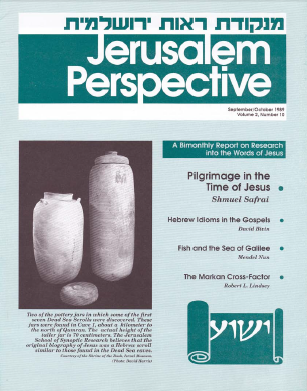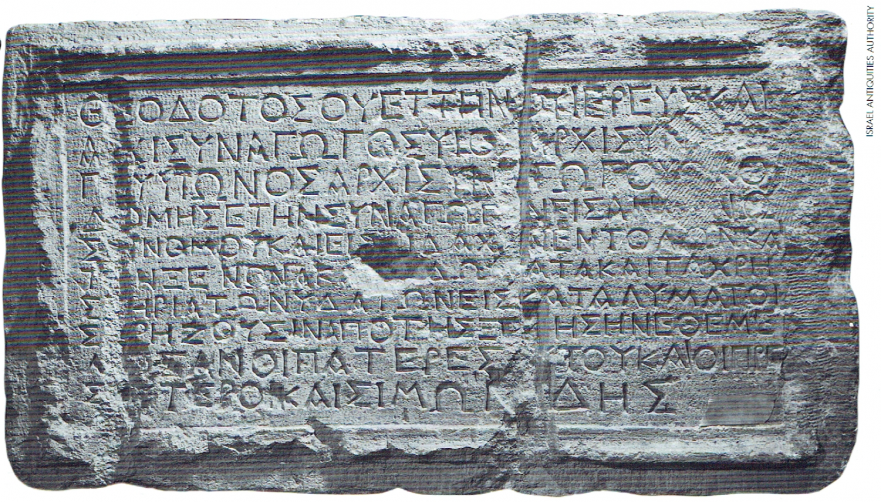This article originally appeared in the JP magazine as a sidebar to Shmuel Safrai’s “Pilgrimage in the Time of Jesus.”
Revised: 21 October 2021Θ[Ε]ΟΔΟΤΟΣ ΟΥΕΤΤΗΝΟΥ ΙΕΡΕΥΣ ΚΑΙ
Α[Ρ]ΧΙΣΥΝΑΓΩΓΟΣ ΥΙΟΣ ΑΡΧΙΣΥΝ[ΑΓΩ]
Γ[Ο]Υ ΥΙΩΝΟΣ ΑΡΧΙΣΥΝ[Α]ΓΩΓΟΥ ΩΚΟ
ΔΟΜΗΣΕ ΤΗΝ ΣΥΝΑΓΩΓΗΝ ΕΙΣ ΑΝ[ΑΓΝΩ]
Σ[ΙΝ] ΝΟΜΟΥ ΚΑΙ ΕΙΣ [Δ]ΙΔAΧ[Η]Ν ΕΝΤΟΛΩΝ ΚΑΙ
Τ[Ο]Ν ΞΕΝΩΝΑ ΚΑ[Ι TΑ] ΔΩΜΑΤΑ ΚΑΙ ΤΑ ΧΡΗ
Σ[Τ]ΗΡΙΑ ΤΩΝ ΥΔΑΤΩΝ ΕΙΣ ΚΑΤΑΛΥΜΑ ΤΟΙ
Σ [Χ]ΡΗΖΟΥΣΙΝ ΑΠΟ ΤΗΣ ΞΕ[Ν]ΗΣ ΗΝ ΕΘΕΜΕ
Λ[ΙΩ]ΣΑΝ ΟΙ ΠΑΤΕΡΕΣ [Α]ΥΤΟΥ ΚΑΙ ΟΙ ΠΡΕ
Σ[Β]ΥΤΕΡΟΙ ΚΑΙ ΣΙΜΩΝ[Ι]ΔΗΣ[1]Theodotos, son of Vettenus, priest and synagogue head, son of a synagogue head, grandson of a synagogue head, built this synagogue—whose foundations were laid by his ancestors, the elders and Simonides—for the reading of Torah and for instruction in the commandments, and the guest house with its rooms and water installations as lodging for needy [pilgrims] from the Diaspora.
(Greek transcription and English translation of the Theodotos inscription)
This Greek inscription was cut into Jerusalem limestone late in the first century B.C.E. It was discovered by Captain R. Weill in 1914, in excavations on the Ophel hill south of the Temple Mount. The inscription provides evidence of the accommodations that were provided in Jerusalem for pilgrims.
The name Vettenus (Οὐέττηνος [Ouettēnos]) mentioned in the inscription is a Latin name, and scholars have suggested that the father of Theodotos was a freedman who had been captured in Pompey’s conquest of Jerusalem in 63 B.C.E. and carried away to Rome as a slave. When he was freed, according to custom he adopted the name of his former master, and returned to Jerusalem. If so, the synagogue referred to in this inscription may have been the Synagogue of the Freedmen mentioned in Acts 6:9, “…those of the synagogue which is called the Synagogue of the Libertini [Freedmen].”
It is not certain from the inscription that Theodotos lived in Jerusalem. He may have sent funds for the building project from Rome. The text of the inscription seems to imply that the synagogue itself originally had been built by Theodotos’ ancestors and others, and that Theodotos only added additional structures, perhaps renovating the synagogue as well.
This is the only remnant of the many synagogues that existed in Jerusalem before the Second Temple was destroyed by the Romans in 70 A.D. According to the Jerusalem Talmud in a saying of Rabbi Hoshaiah quoted by Rabbi Pinhas, the Roman emperor Vespasian had all the synagogues of Jerusalem destroyed:
There were four hundred and eighty synagogues in Jerusalem and each of them had its own school and seminary—a school [בֵּית סֵפֶר, bet sefer, “house of the book”] for (the study of) the Written Torah, and a seminary [בֵּית תַּלְמוּד, bet talmud, “house of study”] for (the study of) the Oral Torah—and Vespasian destroyed them all. (j. Megillah 73d)
Dimensions of the stone: 42.2 cm. high, 74.5 cm. wide and 22 cm. thick.

- [1] Θ[ε]όδοτος Οὐεττήνου, ἱερεὺς καὶ | ἀ[ρ]χισυνάγωγος, υἱὸς ἀρχισυν[αγώ]|γ[ο]υ, υἱωνὸς ἀρχιςυν[α]γώγου, ᾠκο|δόμησε τὴν συναγωγὴν εἰς ἀν[άγνω]|σ[ιν] νόμου καὶ εἰς [δ]ιδαχ[ὴ]ν ἐντολῶν, καὶ | τ[ὸ]ν ξενῶνα, κα[ὶ τὰ] δώματα καὶ τὰ χρη|σ[τ]ήρια τῶν ὑδάτων εἰς κατάλυμα τοῖ|ς [χ]ρῄζουσιν ἀπὸ τῆς ξέ[ν]ης, ἣν έθεμε|λ[ίω]σαν οἱ πατέρες [α]ὐτοῦ καὶ οἱ πρε|σ[β]ύτεροι καὶ Σιμων[ί]δης. ↩































































































